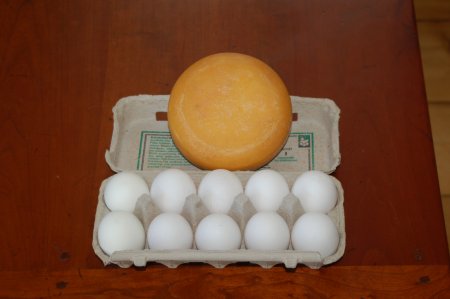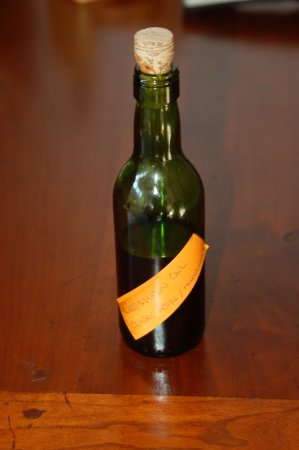No sooner did it arrive did it seem to have been forgotten. On Thursday the UN report, Geo-4, was released. This is the most comprehensive report to date about the state of the world’s global environment. Its 572 pages were written by 390 specialists and reviewed by more than 1000 others. The news was not good.
Decline of fish stocks, degradation of farm land, unsustainable pressure on resources, dwindling supplies of fresh water for people and ecosystems were among the points made in the report.
Two recurring points made in the report were loss of biodiversity and unsustainable agriculture. Thirty crops dominate agriculture and provide about 90% of the world’s calorie intake. Two thirds of the world’s population depend on the input of nitrogen based fertilizers for their food supply. You may wonder what this has to do with home gardening, and I’m going to tell you.
As most of my regular readers know already, many things changed after WWII in both gardening and agriculture. Before this time, there was not a lot of difference between home gardening and farming. Both farmers and gardeners generally saved and traded their own seeds, and while seed companies did exist then they only sold Open Pollinated (OP) seeds that were suitable for seed saving.
There was no need for nitrogen based fertilizers (which were originally created as a means for recycling the stockpiles of chemical weapons that existed after WWII), because people used their own compost and rotated crops that used nitrogen with ones like beans that fixed nitrogen into the ground. Pests and plant diseases that now require the application of pesticides weren’t usually a problem, because crop rotation meant the same plants didn’t play host to these problems from one year to the next, and a healthy garden usually meant beneficial insects would establish themselves to combat crop pests.
After WWII, all over the world, there were major changes in the way food was grown and we were all taught to believe these changes were beneficial. While there were some benefits, mostly these changes were all about creating new farming methods and plant varieties so that farmers could be made dependent on products like seeds and pesticides produced by corporations. Any objections to how everything worked fell mostly on deaf ears, because massive government subsidies meant everyone came out ahead financially anyway.
Initially, there was simply a divergence between gardening and farming, but soon gardeners were encouraged to take advantage of these supposed benefits too. Pesticides and fertilizers were made available to home gardeners, together with the seeds of the new varieties being developed. The seed and chemical companies quickly discovered they could very effectively promote their products with the ‘what if’ scenario. What if you need fertilizer and don’t use it? You better use fertilizer just in case! Most people after they use fertilizer don’t have the slightest idea if it was needed, or what the benefits were. The same logic applies to pesticides – what if you get a disease or insect pests and you haven’t used the right pesticides? Better use them all, just in case. In this way huge amounts of unnecessary products are used in home gardens every year!
In this way too, many gardeners find themselves under a lot of pressure from fellow gardeners who don’t know better, who encourage the use of these products to one another, or sometimes promote ‘organic’ alternatives to these unnecessary products. All this is just free advertising for the chemical companies!
Seed companies only make money if you buy seeds, they don’t make money if you save and trade seeds with other gardeners. Seed companies have the fundamental problem that they have seeds developed for farmers, and the systems of pesticides and fertilizers used, and they need to get home gardeners to grow them too. These are the seeds you find in most seed catalogs and garden centers.
The same ‘what if’ logic is also used for garden seeds. For example seeds with disease resistance for a disease that could only be an issue for farmers is promoted to home growers, in order to make home gardeners afraid to plant anything else. Quietly older varieties of plants are removed from seed catalogs and replaced with new ones, that are supposedly ‘better’ than the inferior old ones. In this way seed companies that offer more new varieties are supposed to make you feel better about buying seeds from them, because what if you accidentally bought an older variety that was inferior somehow. After all, gardeners are supposed to feel excited about getting seeds for the newest varieties of plants to try in their garden.
What’s astonishing is how successful this system of marketing has been over the years in selling seeds to home gardeners. If the seeds of a particular variety of plant aren’t saved and periodically replanted, the variety is just lost. This is because seeds only stay viable for a few years. This period of viability can be extended with techniques like freezing the seeds, but nothing lasts forever. It’s been estimated that in this way, about 70% of the food plant varieties have been lost since WWII, and many more are still lost every year. Even seed banks, tasked with preserving these varieties, have only managed to save a tiny fraction of what used to exist.
Together with this lost of biodiversity is the loss of gardeners who know how these old gardening systems worked, and who are experienced with traditional breeding and seed saving techniques. Even university agriculture programs don’t usually teach these techniques, because they aren’t considered important for modern agriculture.
In recent years reductions in government subsidies have put a much bigger squeeze on farmers financially, who because of local laws and international ‘free trade’ treaties are forced to first buy expensive seeds and chemicals, then sell them the resulting crops below their own costs. Loans are often used to cover the financial short falls, driving farmers into an ever growing cycle of poverty and debt. This has led very large numbers of farmers in India, Australia and many other places to kill themselves in order to escape their debt. Very agressive methods are being used to promote new hybrid rice varieties in Asia for the sole purpose of squeezing farmers financially and leaving them dependent on seed and chemical companies.
So this is all pretty heavy news. What can you as a home gardener do to help the situation?
For seed and chemical companies, the only solution to the world’s agriculture problems will be new varieties of seeds, pesticides and fertilizers. Going back to old varieties of plants will never be an option, and indeed since these older varieties compete with the newer varieties, seed and chemical companies want to see the older varieties disappear.
As a home gardener, you can play steward to some of these old varieties. You can learn some of these mostly forgotten techniques like crop rotations, seed saving and amateur plant breeding. These are the techniques that improve soil instead of degrade it, and increase biodiversity. Organic Guide recently posted on how some of these techniques are being proposed as a solution to the current Australian farming crisis.
Even if you don’t do anything besides learning to identify commercial varieties of plants and not buying these seeds, but rather using your seed buying money to buy OP varieties as well as support some of the few small seed companies that are still around working to preserve old varieties, you can make a big difference.
Growing heirloom and heritage varieties can be very rewarding, and once you get away from the 30 crops mentioned in the UN report as being responsible for 90% of our calorie intake, there’s a whole exciting world of new foods and plant varieties to be found! To see pictures of a few of them, click on the ‘Featured Plant’ link on the sidebar of this blog as well as having a look at these blogs:
Daughter of the Soil
In the Toads Garden
Of course with the excitement will come a few disappointments.




